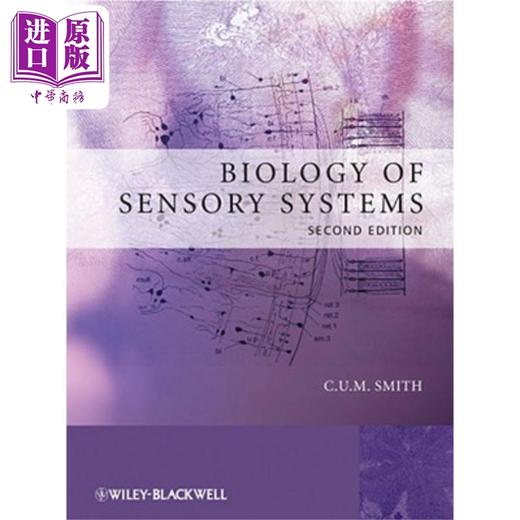预售 【中商原版】感觉系统生物学 第2版修订 Biology of Sensory Systems 英文原版 Christopher Smith 分子生物学 基因
| 运费: | ¥ 0.00-16.00 |
| 库存: | 1 件 |
商品详情
感觉系统生物学 第2版 Biology of Sensory Systems
基本信息
Format:Hardback 536 pages
Publisher:John Wiley & Sons Inc
Imprint:John Wiley & Sons Inc
Edition:2 ed
ISBN:9780470518625
Published:9 Jan 2009
Weight:1191g
Dimensions:253 x 193 (mm)
信息仅供参考,具体请以到手的实物为准
书籍简介●
自一版出版以来,感觉生物学研究取得了巨大发展,特别是分子生物学提供了新的见解。 这些显示了跨物种和跨感觉模式的感觉细胞的分子结构和生理学的相似性,并且通常表明可以追溯到十亿多年前的共同祖先。
因此,《感觉系统生物学》经过彻底修订,采用分子、进化和比较方法,概述了脊椎动物、无脊椎动物和原核生物的感觉系统,重点关注人类感官。
该书由一位具有丰富教学经验的知名作者撰写,分为六个部分,涵盖了感觉系统的一般特征、机械感觉、化学感觉、检测电磁辐射的感觉、其他感觉系统,包括疼痛、热敏性和一些少数感觉系统,还提供了哲学含义的概述和讨论。
本版新增内容:
●更加重视分子生物学和细胞内机制
●基因组学和感觉系统的新篇章
●有关 TRP 通道、突触传递、神经系统进化、蜘蛛类机械敏感感觉器和光感受器、单孔目电感受、语言和 FOXP2 基因、镜像神经元和疼痛分子生物学的部分
●更新了有关人类嗅觉和味觉的段落。
超过四百幅插图、包含补充材料和自我评估问题的盒子以及每个部分末尾的完整参考书目,使《感觉系统生物学》成为生物学、动物学、动物生理学、神经科学、解剖学和生理心理学本科生的读物。 本书也适合视觉科学、验光、神经生理学、神经病理学、发育生物学等更专业课的研究生。
一版的评论好评:
“一本优秀的高级本科生/研究生教科书。” 阿斯利布图书指南
“对比较生物学和进化论的强调是这本独立的书的显着特征之一......这是一本内容丰富且发人深省的文本......”泰晤士报高等教育增刊
Since publication of the first edition, huge developments have taken place in sensory biology research and new insights have been provided in particular by molecular biology. These show the similarities in the molecular architecture and in the physiology of sensory cells across species and across sensory modality and often indicate a common ancestry dating back over half a billion years.
Biology of Sensory Systems has thus been completely revised and takes a molecular, evolutionary and comparative approach, providing an overview of sensory systems in vertebrates, invertebrates and prokaryotes, with a strong focus on human senses.
Written by a renowned author with extensive teaching experience, the book covers, in six parts, the general features of sensory systems, the mechanosenses, the chemosenses, the senses which detect electromagnetic radiation, other sensory systems including pain, thermosensitivity and some of the minority senses and, finally, provides an outline and discussion of philosophical implications.
New in this edition:
Greater emphasis on molecular biology and intracellular mechanisms
New chapter on genomics and sensory systems
Sections on TRP channels, synaptic transmission, evolution of nervous systems, arachnid mechanosensitive sensilla and photoreceptors, electroreception in the Monotremata, language and the FOXP2 gene, mirror neurons and the molecular biology of pain
Updated passages on human olfaction and gustation.
Over four hundred illustrations, boxes containing supplementary material and self-assessment questions and a full bibliography at the end of each part make Biology of Sensory Systems essential reading for undergraduate students of biology, zoology, animal physiology, neuroscience, anatomy and physiological psychology. The book is also suitable for postgraduate students in more specialised courses such as vision sciences, optometry, neurophysiology, neuropathology, developmental biology.
Praise from the reviews of the first edition:
"An excellent advanced undergraduate/postgraduate textbook." ASLIB BOOK GUIDE
"The emphasis on comparative biology and evolution is one of the distinguishing features of this self-contained book. .... this is an informative and thought-provoking text..." TIMES HIGHER EDUCATIONAL SUPPLEMENT
作者简介
克里斯托弗·阿普汉姆·默里·史密斯博士。 英国伯明翰阿斯顿大学视觉科学荣誉客座研究员。
Dr. Christopher Upham Murray Smith. Honorary Visiting Fellow, Vision Sciences, Aston University, Birmingham, UK.
目录
部分目录,仅供参考
Preface to Second Edition.
Preface to First Edition.
PART I: PRELIMINARIES.
Chapter 1: Elements.
1.1 Allosteric Effectors.
1.2 Membranes.
1.3 Membrane Signalling Systems.
1.4 Channels and Gates.
1.5 Concluding Remarks.
Chapter 2: Membranes, Action Potentials, Synapses.
2.1 The Measurement of Resting Potentials.
2.2 The Ionic Bases of Resting Potentials.
2.3 Electrotonic Potentials and Cable Conduction.
2.4 Receptor and Generator Potentials.
2.5 Sensory Adaptation.
2.6 Action Potentials.
2.7 Synapses and Synaptic Transmission.
2.8 Concluding Remarks.
Chapter 3: General Features of Sensory Systems.
3.1 Classification of the Senses.
3.2 Modality.
3.3 Intensity.
3.4 Adaptation.
3.5 Receptive Fields.
3.6 Maps of Sensory Surfaces.
3.7 Hierarchical and Parallel Design.
3.8 Feature Extraction and Trigger Stimuli.
3.9 Concluding Remarks.
Box 3.1 Hermann von Helmholtz.
Chapter 4: Classification and Phylogeny.
- 中商进口商城 (微信公众号认证)
- 中商进口商城中华商务贸易有限公司所运营的英美日韩港台原版图书销售平台,旨在向内地读者介绍、普及、引进最新最有价值的国外和港台图书和资讯。
- 扫描二维码,访问我们的微信店铺
- 随时随地的购物、客服咨询、查询订单和物流...










